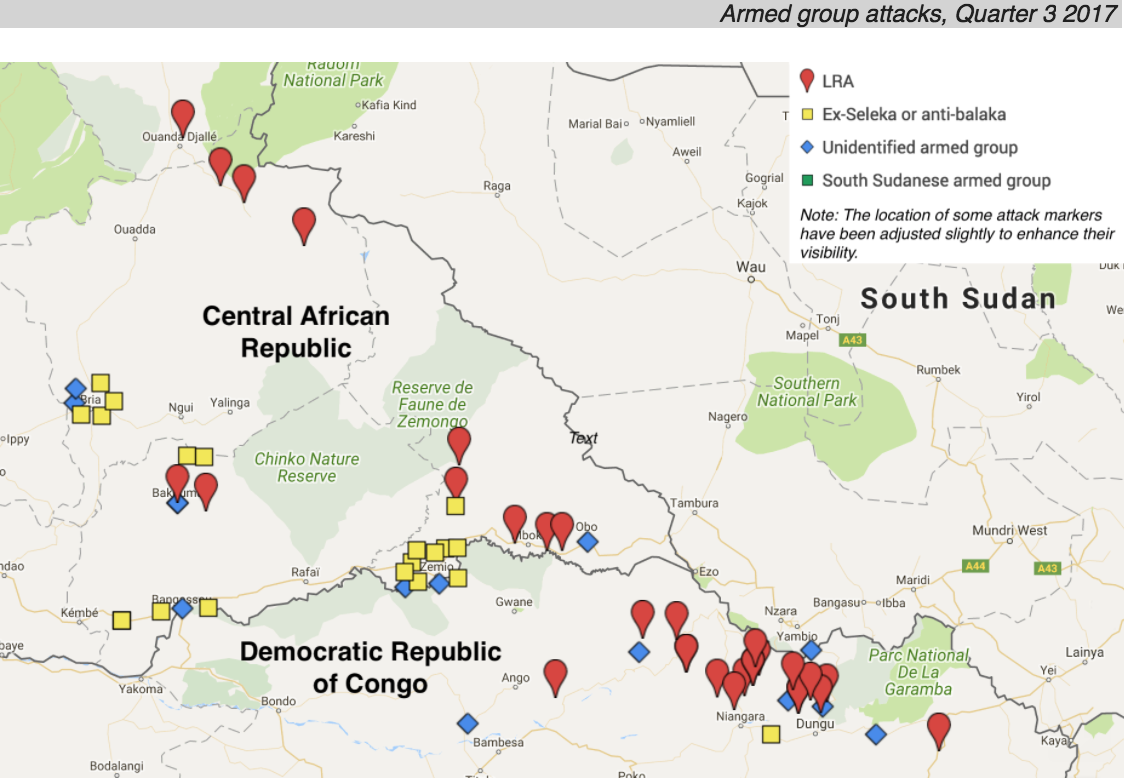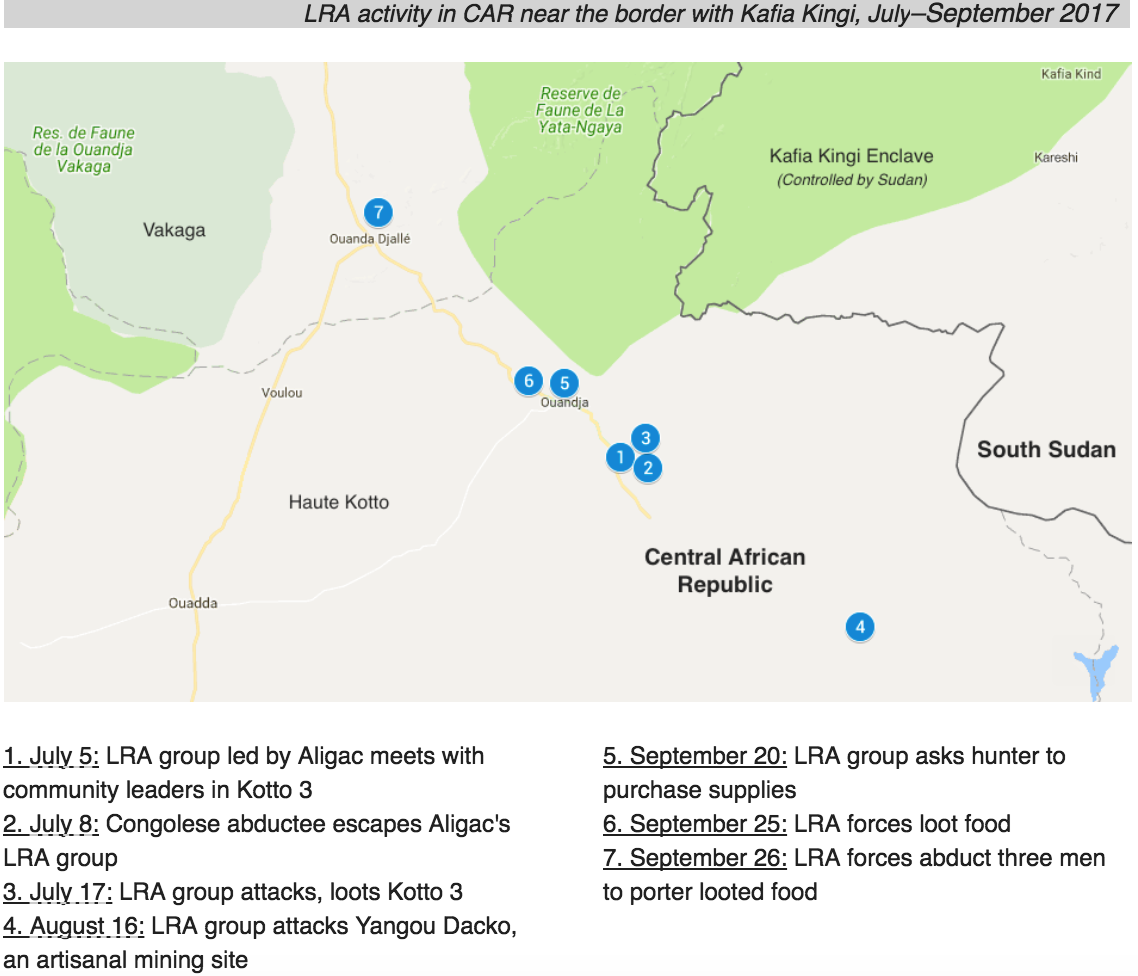Clashes between armed groups and attacks on civilians continued to dominate the security landscape in the Mbomou-Uele border region* in Quarter 3 (July–September) 2017. In eastern Central African Republic (CAR), fighting involving ex-Seleka factions, anti-balaka militias, and other armed actors was concentrated in towns such as Bria (Haute Kotto prefecture) and Zemio (Haut Mbomou prefecture), while security improved in other locations, such as Bangassou (Mbomou prefecture).
Though the overall number of attacks and abductions by the Lord’s Resistance Army (LRA) declined in Quarter 3, LRA activity did spike in areas of Haute Kotto near the border with the Sudanese-controlled Kafia Kingi enclave. In northeastern Democratic Republic of Congo (DRC), the LRA was responsible for most armed group activity, committing a series of abductions and attacks west of Garamba National Park during and following operations to collect ivory.
Pour lire la version française de ce rapport, cliquez ici.

Overall violence decreases in eastern CAR, with pockets of continued attacks
Overall levels of armed group attacks and killings in Haute Kotto, Mbomou, and Haut Mbomou prefectures decreased in Quarter 3 compared to Quarter 2 (April–June) 2017, but remained far above levels in previous years. Most violence against civilians has been perpetrated by “anti-balaka” militias, whose allegiances and level of organization vary widely across the region, or factions within the Front Populaire pour la Renaissance de la Centrafrique (FPRC), the Union pour la Paix en Centrafrique (UPC), and other groups associated with the ex-Seleka.
In Haute Kotto, the regional capital of Bria remained a hotspot, with sporadic clashes involving warring FPRC factions, anti-balaka militias, and other armed groups. In late September, civil society leaders helped to mediate a ceasefire between several armed armed groups operating in Bria, leading to a reduction in violence. On October 6, leaders from FPRC, UPC, and anti-balaka factions were among those that signed a ceasefire in Ippy, 89 km west of Bria in Ouaka prefecture. However, shifting political alliances and continued jockeying for control over natural resources and other sources of revenue will likely test the viability of these initiatives in the coming weeks.
In Mbomou prefecture, sporadic clashes were also reported, highlighted by fighting between UPC and anti-balaka combatants in Gambo in early August that killed six Red Cross volunteers. In Bangassou, where anti-balaka groups targeted Muslim neighborhoods and MINUSCA peacekeepers in May 2017, efforts by MINUSCA helped prevent major atrocities by armed groups in Quarter 3, though tensions remained high and there were sporadic incidents of violence.
Further east, in Haut Mbomou prefecture, armed group violence in Quarter 3 was concentrated in and near the town of Zemio. There were at least nine attacks within a 25km radius of the town, displacing tens of thousands of Central Africans and Congolese refugees. Many Central Africans and Congolese fled from Zemio into areas of DRC’s Bas Uele province from which Congolese refugees in Zemio had originally fled to avoid attacks by the LRA. Though LRA activity in these areas of Bas Uele has been infrequent in 2017, the group was very active there in 2015 and 2016and could return to attack newly arrived displaced people.
The complicated role of the Peuhl ethnic group in violence in eastern CAR
People from the minority Peuhl ethnic group were involved in much of the violence in Haut Mbomou prefecture in Quarter 3 2017, either as perpetrators or victims. In and near Zemio, Peuhl men were identified as among the combatants in seven attacks involving violence against civilians and/or clashes with anti-balaka groups. On July 14, an unidentified armed group murdered five Peuhls, including two men, two women, and a young girl, near Obo. Peuhl leaders in Obo played an important role in conflict mediation and reconciliation efforts facilitated by local authorities and civil society groups, which reduced subsequent tensions and helped prevent the incident from sparking further violence in Obo.
In many of the incidents in Zemio, it remains unclear whether armed Peuhl were associated with the Peuhl-dominated UPC or acting independently. The UPC was one of the factions that splintered from the Muslim-majority Seleka movement when it collapsed in 2014. It is led by Ali Darassa, a Peuhl who has links with a Chadian Peuhl rebel leader who previously operated in CAR, Abdel Kader Baba Ladde. In February, Ali Darassa and the UPC were expelled from Bambari (Ouaka prefecture) by MINUSCA peacekeepers, leading to expanded UPC activity in Basse Kotto, Haute Kotto, Mbomou, and Haut Mbomou prefectures.
Attacks on civilians by the UPC, as well as by anti-balaka and other armed groups, have heightened tensions between civilians from different ethnic and religious groups, sometimes forcing them to seek safety or protection from armed groups dominated by combatants with similar identities. However, armed groups have most often acted in their own self-interest, rather than that of the ethnic and/or religious groups they often claim to represent. Armed group alliances are often shifting and based on attempts to consolidate control over territory or sources of revenue. In mid-2017, members of the FPRC, which, like the UPC, emerged from Seleka’s dissolution, collaborated with predominantly Christian anti-balaka militias to target the UPC and Peuhl civilians. Such alliances highlight that, while armed groups often target civilians based on their religious or ethnic identities, such differences are not intrinsic to the violence.
LRA commanders attack, engage Central African communities near Kafia Kingi
On July 5, an LRA group abruptly entered the town of Kotto 3, a small community in CAR’s Haute Kotto prefecture that lies just 45km from the border with Sudanese-controlled Kafia Kingi enclave. Aligac and Otim Larwedo, the commanders of the LRA group, asked to meet with local ex-Seleka and community leaders, requesting food and expressing an interest in defecting. The group left the next day, never following up on their claims to desert the LRA. Two weeks later, an LRA group, possibly the same one, returned to attack and loot supplies from Kotto 3.
In August and September, LRA fighters continued to operate around Kotto 3 and the neighboring community of Sam Ouandja. In one incident, LRA combatants stopped a hunter in the bush, gave him cash, and requested that he purchase supplies for them in local markets. LRA forces also periodically looted farmers and mining communities near Sam Ouandja and Kotto 3. On September 26, LRA forces attacked a field near Ouanda Djalle in neighboring Vakaga prefecture, the first reported LRA activity there since October 2010.
Very little information has emerged about Kony’s whereabouts since the end of US and Ugandan counter-LRA operations in April 2017, in part because few LRA combatants have escaped the rebel group since then. However, the spike in LRA activity in Haute Kotto and Vakaga in Quarter 3 could be an indication that the LRA leader continues to operate along the border of CAR, the Kafia Kingi enclave, and South Darfur. In the past, analysis comparing LRA attack patterns in Haute Kotto and Vakaga with testimonies from LRA defectors of Kony’s movements has demonstrated links between spikes in attacks there with Kony’s presence in Kafia Kingi.

LRA group attacks communities as it traffics ivory in DRC
In DRC, LRA activity in Quarter 3 was concentrated west of Garamba National Park and surrounding protected areas in Haut Uele province. Following orders from Kony in May 2017, an LRA group led by Owila attacked communities there for several weeks, abducting 35 people in 17 attacks between May and July 2017. Simultaneously, Owila’s group sought to gather ivory, though it remains unclear if they poached elephants in Garamba or unearthed ivory caches buried during LRA poaching missions in previous years.
By mid-August, Owila’s group had started to move west and north, towards the border with CAR. His group was likely responsible for attacks near Bangadi, Zigbi, and Mbangana from August 14–24 in which a total of more than 30 people were temporarily abducted to porter looted goods. The survivors abducted near Bambangana later released reported that Owila’s group possessed 16 pieces of ivory. As Owila’s group moved towards CAR, LRA violence in communities surrounding Garamba dropped, with no LRA attacks reported near Garamba (i.e. east of Ngilima) since August 4.

* The LRA Crisis Tracker is a project of Invisible Children that incorporates data on armed group activity in the Mbomou-Uele border region, a geographic area that includes the prefectures of Haute Kotto, Mbomou, and Haut Mbomou in eastern CAR and areas of Haut Uele and Bas Uele provinces in northeastern DRC north of the Uele River. Information on armed group activity from neighboring areas of CAR, DRC, South Sudan, and Sudan is incorporated into our analysis of conflict dynamics in the Mbomou-Uele border region. Visit the LRA Crisis Tracker website at www.LRAcrisistracker.com
Think people should hear about this?